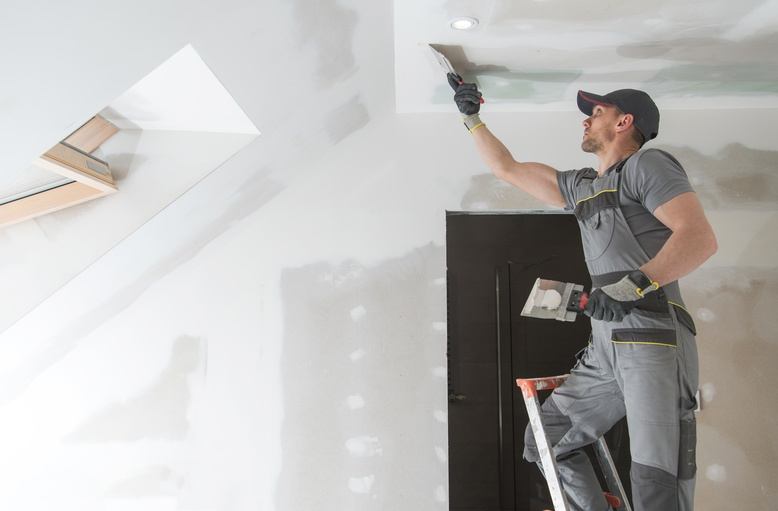Advanced Techniques for Efficient Drywall Installation
Advanced Techniques for Efficient Drywall Installation
Blog Article
Everything You Required to Understand About Drywall Installation: A Comprehensive Guide

Understanding Drywall Fundamentals
Recognizing the fundamentals of drywall is crucial for any type of successful setup project. Drywall, additionally recognized as gypsum board or plasterboard, is a prominent building product made use of to develop interior walls and ceilings.
The most common types include regular drywall, moisture-resistant drywall, and fireproof drywall. Routine drywall is ideal for the majority of interior applications, while moisture-resistant drywall is advised for areas with high moisture, such as restrooms and kitchens.
Another secret element of drywall fundamentals is comprehending the standard sizes and thicknesses readily available. The most usual sizes are 4x8 feet and 4x12 feet, with thicknesses ranging from 1/4 inch to 5/8 inch. Thicker drywall is usually made use of for applications that require enhanced fire resistance or soundproofing.
Tools and Products Needed for Drywall Installment
To successfully mount drywall, it is vital to have the necessary devices and products accessible (drywall Edmonton). These devices and materials are vital for accomplishing a specialist coating and making certain the resilience of the installation
Firstly, you will require a measuring tape to properly gauge the measurements of the area where the drywall will be installed. An utility knife is vital for reducing the drywall to the needed dimension and form. Additionally, a drywall saw can be used for making a lot more intricate cuts, such as around electrical outlets or windows.
Following, you will need a screw gun or a drill with a screwdriver bit to safeguard the drywall to the wall studs. Screws, particularly drywall screws, are essential for connecting the drywall to the studs. It is necessary to make use of the ideal length of screws to guarantee a safe and secure and flush setup.

In terms of products, you will require the drywall itself, joint compound for loading in joints and spaces, and tape for enhancing the joints. Sandpaper or a sanding block will certainly be needed for raveling the joint compound after it has actually dried.
Preparing the Area for Drywall Installment
Prior to waging the drywall installment, it is necessary to appropriately prepare the space to guarantee a smooth and successful installment procedure. Preparing the room entails numerous important steps that need to be complied with carefully.
To start with, it is critical to get rid of the area of any kind of furnishings, components, or various other things that may block the installment procedure. This will offer the installers with adequate room to function and navigate around. Additionally, it is recommended to cover the floors and any remaining items with safety sheets or ground cloth to avoid any type of damage or debris from dropping onto them.
Following, it is essential to examine the wall surfaces and ceiling for any type of existing damages, such as fractures, holes, or water spots. These problems should be repaired prior to the installation to ensure a smooth and even surface for the drywall. Any kind of loosened paint or wallpaper need to likewise be gotten rid of, and the wall surfaces should be thoroughly cleaned and dusted.
Furthermore, electrical and plumbing fixtures need to be closed off and secured to stop any accidents or damage during the installment procedure. It is vital to transform off the power supply to the location and remove any kind of electrical cover layers prior to starting the setup.
Lastly, it is suggested to seek advice from with a specialist or refer to regional building ordinance to make sure conformity with security policies and acquire any type of needed authorizations prior to continuing with the installation. By properly preparing the space, you can guarantee a effective and effective drywall installment process.
Step-by-Step Guide to Hanging Drywall
To ensure a successful drywall installation, it is essential to adhere to a detailed overview for hanging the drywall (Edmonton drywallers). This process calls for precision and focus to detail
First, collect all the needed tools and products, consisting of drywall sheets, an utility knife, a drywall saw, a tape step, a drill, and screws.
Following, start by gauging the measurements of the wall surface or ceiling where the drywall will certainly be mounted. Transfer these dimensions onto the drywall sheets, noting Check This Out where cuts need to be made - Edmonton drywallers. Utilize a straight edge and an energy blade to rack up the drywall along the marked lines, then snap it along the score line
When the drywall sheets are cut to dimension, they can be hung on the wall or ceiling. Start at one edge and place the very first sheet vertically against the framework. Use screws to protect the drywall to the studs, seeing to it to leave a little space between sheets for development.
Continue this process, working your way throughout the wall or ceiling. Ensure that each sheet is level and flush with nearby sheets. Make use of a drywall saw to reduce out any required openings for electric outlets or buttons.
Ending Up Techniques for a Specialist Look
Now that the drywall sheets have actually been successfully hung, it is important to employ ending up methods that will lead to a refined and expert look. Achieving a smooth and remarkable coating on drywall calls for mindful focus to detail and making use of appropriate tools and strategies. One of the initial steps in the completing procedure is to fill the joints and screw indentations with joint compound. This can be done by using a slim layer of substance over the joints utilizing a taping knife, and afterwards embedding drywall tape into the compound. As soon as the tape is in place, an additional layer of compound must be used over it, go feathering the edges to produce a smooth shift. After the substance has actually dried out, it is essential to sand the surface to get rid of any kind of flaws and develop a smooth surface. A pole sander or sanding block can be made use of for this objective. Last but not least, the walls must be topped and painted to complete the ending up procedure. Utilizing high-quality paint and applying it uniformly with a roller or brush will guarantee a expert and durable coating. By following these completing strategies, your drywall installation will certainly have a specialist and refined look.
Final Thought
To conclude, understanding the fundamentals of drywall installation is vital for a successful project. By utilizing the appropriate tools and products, preparing the room sufficiently, and adhering to a detailed overview, one can accomplish a professional-looking surface. Focus to completing strategies will further improve the general look. With this detailed overview, any individual can with confidence take on a drywall installment project.
The most common types include routine drywall, moisture-resistant drywall, and fireproof drywall. Regular drywall is appropriate for many interior applications, while moisture-resistant drywall is advised for areas with high humidity, such as restrooms site and cooking areas. Screws, specifically drywall screws, are necessary for affixing the drywall to the studs. These concerns ought to be fixed before the setup to make certain a smooth and even surface for the drywall. By adhering to these finishing methods, your drywall setup will certainly have a sleek and professional look.
Report this page